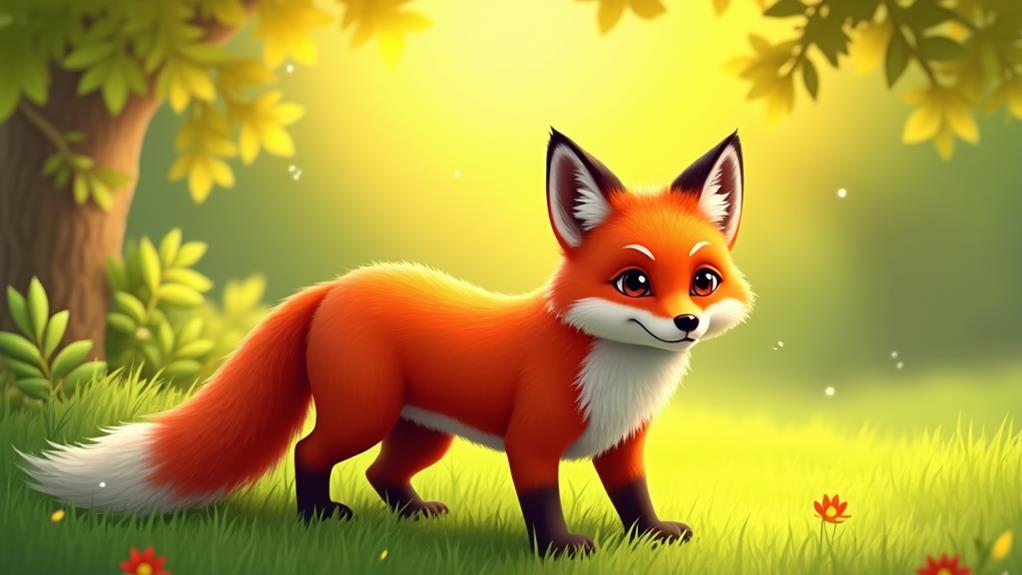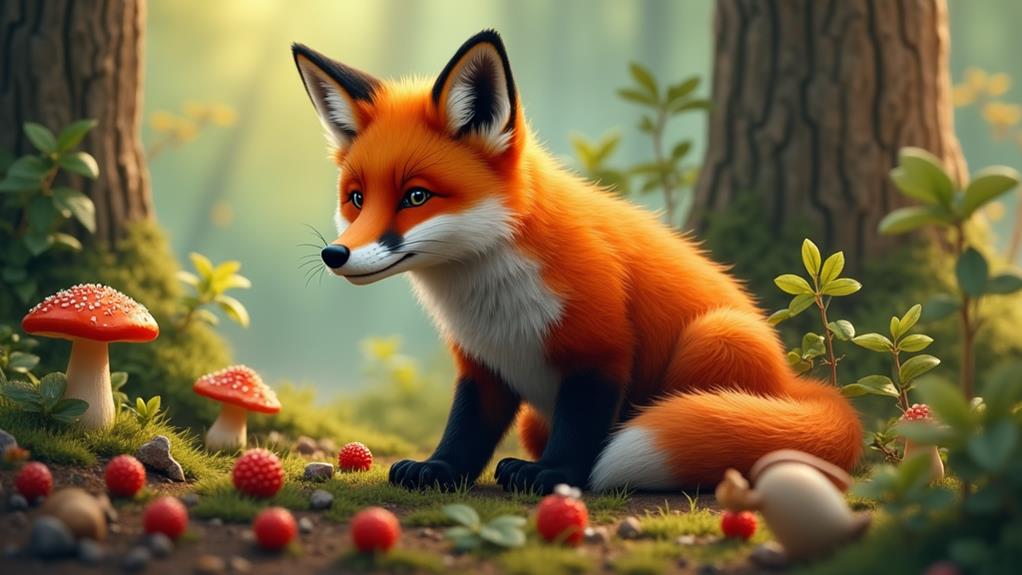You're in for a treat with red foxes! These clever creatures have distinctive reddish-orange coats and can weigh anywhere from 8 to 30 pounds. Surprisingly adaptable, they thrive in forests and urban areas alike. Their ability to hear sounds from up to 40 yards away helps them hunt effectively, often using a pouncing technique called "mousing." Red foxes also have a playful side, forming family groups called a skulk. They communicate with over 40 unique sounds! With their fascinating social behavior and intelligence, these little tricksters never cease to amaze—want to uncover more curious facts?
Contents
Unique Physical Features

When you think of red foxes, their unique physical features immediately stand out. These charming creatures flaunt a distinctive reddish-orange coat that's simply stunning, although you might spot variations in colors like grey, blackish-brown, and even platinum.
Weighing between 8 to 15 pounds, these nimble animals can surprisingly reach up to 30 pounds. Quite the range, right? Their diverse habitats, from forests to urban areas, contribute to the variety of their physical adaptations. For instance, those found in the Arctic tundra possess thick fur and fat layers to insulate against extreme cold, showcasing their adaptability to various environments.
Their body measures about 17 to 35 inches in length, and let's not forget their bushy tails, known as a "brush," which can add an extra 12 to 16 inches. These fluffy tails aren't just for show; they help with balance and warmth!
Now, let's talk about those adorable pointed ears. They're not just cute; they provide red foxes with exceptional hearing ability, letting them pick up sounds from great distances—think of it as their own built-in superhero power!
With five digits on their front paws and four on the back, plus an extra toe for traction, red foxes have the perfect paws for maneuvering slippery surfaces.
Diverse Habitat Range
Diverse Habitat Range]
Did you know that red foxes are some of the most adaptable creatures on the planet? They call all sorts of places home, from sprawling forests to bustling cities, demonstrating their versatility in thriving in both urban and rural environments.
In fact, red foxes often form larger populations in urban settings due to greater access to food sources, showcasing their remarkable adaptability to urbanization. They can make a cozy den just about anywhere—even under your porch!
Let's explore where these clever critters thrive and how they've learned to live alongside us, sometimes even outsmarting our attempts to keep them at bay.
Global Distribution of Foxes
Red foxes stand out as the most widespread land mammals, thriving in diverse habitats across 83 countries in North America, Europe, and Asia.
These clever creatures roam a staggering natural range of approximately 27 million square miles! They exhibit fascinating adaptations notable species include, calling forests, grasslands, mountains, and even urban areas home, showing off their extraordinary adaptability wherever they go.
What's really cool is how well red foxes do in human-populated spaces. You might spot one in a city park or even your own garden, traversing our landscapes as if they owned the place.
They've proven they can handle all sorts of climates too. From the icy Arctic tundra to sunny deserts, these foxes adapt brilliantly as a species.
Their presence often reflects the quality of their habitats. So, if you're lucky enough to see one, it's a good indication that the environment's thriving!
It's fascinating to think about how these little mammals manage to blend into so many different settings. So, next time you hear a rustle in the bushes, it might just be a red fox, enjoying its vast, vibrant home!
Urban Adaptation Strategies
Urban spaces offer red foxes unique opportunities for survival and growth. These clever creatures have some fantastic urban adaptation strategies that help them thrive amid bustling human life.
With their omnivorous diet, red foxes munch on everything from small mammals and birds to fruits and those tasty leftovers we might leave behind. They've turned city parks and backyards into their personal banquet halls!
You might be surprised to know that urban foxes often make their homes in the most unconventional spots. They'll dig dens under porches or in gardens, cleverly using our structures for safety and shelter.
How resourceful, right? By being mostly nocturnal, red foxes dodge the hustle and bustle of daytime activities. They come out to hunt when it's quieter, showcasing their ability to adapt and survive.
Thanks to their resilience, red foxes maintain stable populations even in heavily urbanized areas. It's like they're saying, "We can adapt to anything!"
Preferred Habitats Explained
Known for their incredible adaptability, red foxes thrive in a variety of habitats, making them the most widespread land mammals on the planet. You might be surprised to learn that they inhabit about 27 million square miles across North America, Europe, and Asia. That's a lot of ground to cover!
Red foxes are true survivors, comfortably residing in forests, grasslands, mountains, and even urban areas. When they invade our neighborhoods, you'll often find them snuggled under porches, in sheds, or sheltered by bushes. How cozy!
Their favorite spots include forest edges and mixed shrublands, where they can stealthily hunt and find refuge from predators.
Thanks to their remarkable adaptation skills, red foxes have managed to maintain stable populations, even in the face of challenges like habitat loss and urbanization. It's inspiring to see how they coexist with humans and other wildlife, showing us the beauty of diversity in habitats.
Omnivorous Diet

When you think of red foxes, picture them as nature's very own foodies!
Their omnivorous diet means they're not picky eaters, munching on everything from small mammals to juicy fruits and even those leftover pizza slices you didn't finish.
And with their clever hunting techniques, like sneaking up on unsuspecting rodents, it's no wonder they adapt so well to different environments, urban or otherwise!
Diverse Food Sources
Red foxes' adaptability is largely due to their omnivorous diet, which allows them to thrive in various environments. These clever critters feast on a diverse diet that includes small animals like rabbits and rodents, birds, fruits, and even insects.
Imagine hunting for a quick snack in your backyard; that's what red foxes do every day!
This adaptability means they can find something to eat almost anywhere. When other food sources are low, they've been known to scavenge human leftovers. We can hardly blame them; who doesn't love a leftover treat now and then?
Plus, red foxes help keep the rodent population in check, making sure our gardens and parks remain balanced and healthy.
And here's something fun: they often cache food! When they catch more than they can eat, they store it for a rainy day. It's like saving those extra cookies for later, only their cookies are small animals.
Hunting Techniques Explained
With their keen instincts and impressive skills, red foxes excel in hunting through various techniques, adapting to their omnivorous diet. One standout method is called "mousing," where these clever creatures stalk and pounce on unsuspecting rodents. It's a display of agility and stealth that would impress even the most seasoned predator!
Thanks to their exceptional hearing, red foxes can pick up the faintest sounds—like a watch ticking—up to 36 meters away, which helps them find prey hidden underground. They're the ultimate opportunistic eaters, often caching food by burying it for later. Talk about a foodie hack for tough times!
But here's the real kicker: red foxes have been seen using the Earth's magnetic field to boost their hunting accuracy. Imagine being so attuned to nature that you can literally follow invisible lines to your next meal! It's as if they've got a built-in compass guiding them toward success.
These clever tactics allow red foxes to thrive, ensuring they're well-fed and ready for whatever challenge comes next. After all, who wouldn't want to learn a thing or two from these remarkable hunters?
Social Behavior Patterns
Solitary by nature, foxes often exhibit fascinating social behaviors, especially when raising their young. You might be surprised to learn that these clever creatures mainly interact within small family groups called a skulk, typically made up of a mother and her kits.
Unlike wolves, they don't form large packs, which gives their social interactions a cozy, intimate feel.
Young foxes are playful, engaging in fun activities that help them sharpen their social skills and build strong bonds with one another. It's like a tiny fox playground!
Communication plays a critical role in their lives; red foxes have over 40 distinct vocalizations. They use these sounds to alert each other about danger or to attract a mate.
When it comes to their territory, red foxes are quite serious. They mark their home ranges with scent, a natural way of communicating their presence and warding off intruders.
This territorial behavior helps maintain their space while also keeping family units safe. So, next time you spot a fox, remember there's so much more going on beneath that bushy tail than meets the eye!
Breeding and Lifecycle

Typically, foxes breed once a year, aligning their mating season with the winter months. Mating usually takes place between January and early February. After about 52 days of anticipation, a proud fox parent welcomes a litter of 4 to 6 kits around March or April.
Here's a bit about their lifecycle:
- Newborn Kits: These little bundles of joy are born blind and depend completely on their parents for care and nourishment, making them a handful for a few weeks.
- Exploration Time: Around three weeks old, kits start poking their tiny noses out of the den, enthusiastic to explore their new world.
- Learning: For about seven months, young foxes stick with their parents, soaking up essential survival skills. There's a lot to learn!
- Independence Day: Eventually, they're ready to fly the nest and establish their own territories, prepared to take on the wild.
Watching them grow is a remarkable journey. Breeding and nurturing these kits aren't just about survival; it's also about teaching them the ways of the world. Nature does know how to keep it cute and exciting!
Conservation Status
Understanding the conservation status of red foxes reveals a complex picture. While the International Union for Conservation of Nature (IUCN) classifies them as Least Concern, indicating stable populations mainly, there's more beneath the surface.
For example, there are 45 different subspecies of red foxes. Sadly, the Sierra Nevada red fox is critically endangered, with only about 50 individuals left.
Urbanization and habitat loss pose significant threats, particularly where sprawling human development gets too cozy with their natural homes.
But don't fret! There are plenty of dedicated folks working on conservation efforts for red foxes. They focus on habitat preservation, education, and raising public awareness to guarantee that these clever creatures continue to thrive in both urban and rural settings.
Even with a generally stable status, red foxes still have some hurdles to jump, like poaching and competition with other species.
So, when you think about these foxes, remember they're not just thriving; they need your support. By being aware and advocating for their protection, you're helping preserve the wildlife that makes our world that much more vibrant and exciting.
Who wouldn't want a world where red foxes roam?
Exceptional Hunting Skills
When you think about red foxes, their exceptional hunting skills really set them apart in the animal kingdom.
These clever creatures are masters of disguise, thanks to their incredible talents. Here are some fascinating factors that showcase their abilities:
- Exceptional Hearing: Red foxes can detect sounds from up to 40 yards away, including the tiny rustling of rodents hiding underground. They're like nature's ultimate sound detectors!
- Earth's Magnetic Field: Believe it or not, red foxes can use the Earth's magnetic field to orient themselves while hunting. Talk about a built-in GPS!
- Hunting Technique: Their signature approach, known as "mousing," involves a stealthy creep, followed by a powerful pounce—perfect for catching unsuspecting mice.
- Speed Demons: They can run at speeds of up to 30 mph! This ability helps them chase down prey while cleverly dodging bigger predators.
With their keen sense of smell and night vision, red foxes truly dominate the nighttime landscape.
Whether they're outsmarting prey or just looking cute, these furry specialists highlight the wonders of nature in action!
Cultural Significance
Red foxes have woven their way into the fabric of various cultures, becoming powerful symbols of cleverness and adaptability. You might be surprised to learn how their reputation stretches from the forests of North America to the fairy tales of Europe!
In Native American traditions, red foxes are often portrayed as cunning tricksters, showcasing their resourcefulness in tricky situations.
In Europe, these clever critters are sometimes painted as sly and deceitful, always managing to outsmart both predators and humans. This reputation for cleverness isn't just for fun; it's a nod to their unique ability to adapt to different environments, showcasing their resilience.
You can see their cultural significance pop up in literature and art, where red foxes often star as clever protagonists, cleverly overcoming challenges with agility and wit.
They even feature in wildlife documentaries, highlighting their fascinating behaviors and adaptability.
Urban Adaptation

Foxes have proven their versatility beyond rural landscapes, thriving in urban areas where human presence is prevalent. You might be surprised to see how these clever red foxes adapt to city living, carving out a niche in our backyards and parks.
Their urban adaptation is quite fascinating! Just take a look at how they've mastered the art of city life:
- Clever Shelters: Urban red foxes often create cozy dens under porches or in gardens, using human-made structures for safety.
- Nocturnal Hunters: They're night owls, hunting small mammals and birds under the cover of darkness, which keeps them safe from prying eyes.
- Opportunistic Eaters: Their diet includes everything from fruits to human leftovers, showcasing their opportunistic feeding behavior as they find what's available.
- Growing Populations: With increasing resources in cities, red fox populations have surged, illustrating their remarkable flexibility.
These furry urbanites coexist with us, reminding us that nature can be robust and adaptable.
Final Thoughts
So, next time you spot a red fox, remember they're more than just a pretty face! Did you know that a single fox can cover up to 12 miles in a night while hunting? That's some serious cardio! With their unique features and clever behaviors, these crafty creatures capture our hearts and imaginations. Let's appreciate and protect them, because their presence enriches our world in so many ways, from the countryside to the hustle and bustle of urban life!














